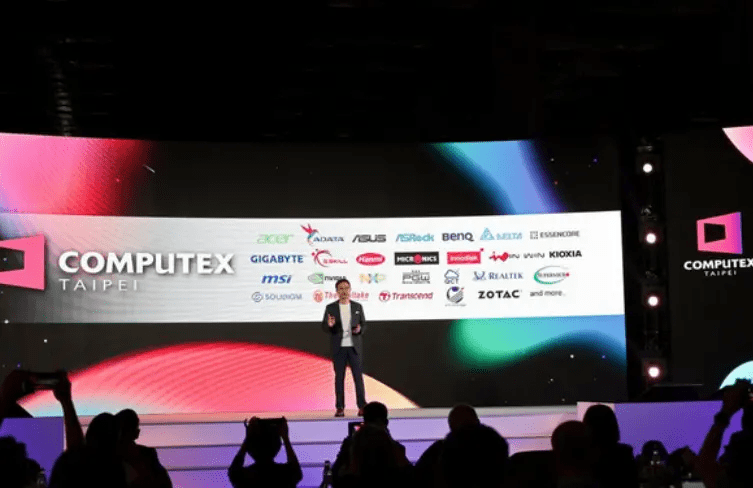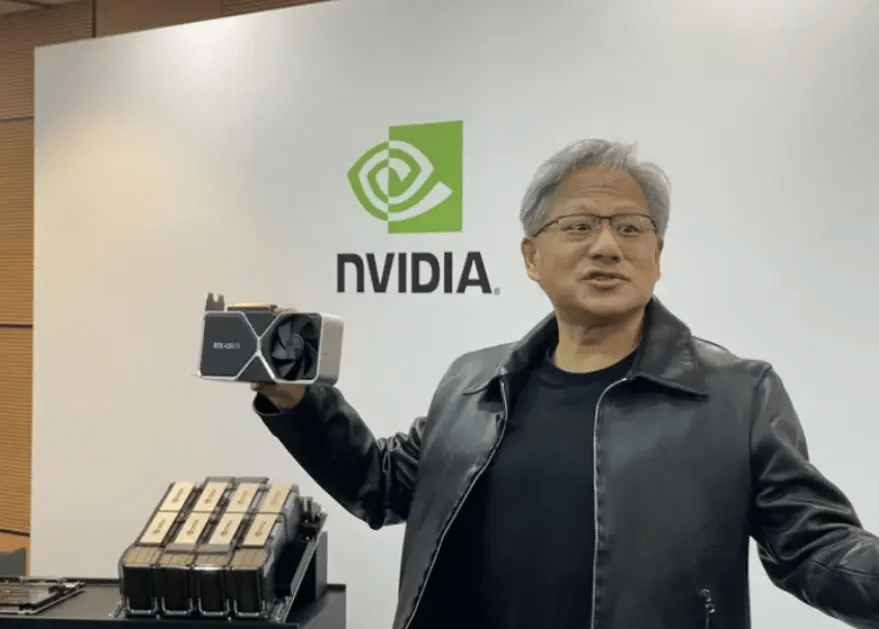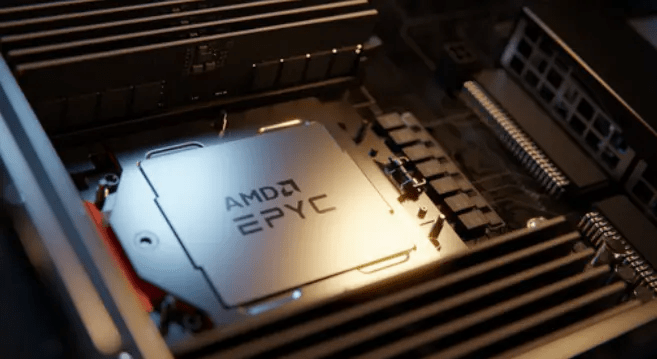
The 2023 Taipei International Computer Show (COMPUTEX 2023) will be held in Taipei from May 30 to June 2. Efficient computing will be one of the six major themes of COMPUTEX 2023. NVIDIA, AMD, Intel, Qualcomm, ARM, Tenstorrent Waiting for them all to appear, bringing together forward-looking products and solutions, AI swept the entire exhibition hall, COMPUTEX 2023 is more like an AI exhibition.

With its strong performance, NVIDIA has almost monopolized the changes in the field of artificial intelligence at Computex Taipei. NVIDIA CEO Jen-Hsun Huang not only released new products continuously, but also showed off AI solutions with partners. AMD and Intel took the initiative to avoid its edge and compete with them in AI from a distance, staging a smokeless AI war.
Qualcomm, Arm and other manufacturers can only stand aside and cannot compete with NVIDIA in the AI home field. They can only let AI improve the performance of their own products to better seize opportunities in the mobile and PC markets.
NVIDIA Huang Renxun is in the limelight
On May 30, Nvidia’s market value exceeded the US$1 trillion mark, becoming the seventh semiconductor company in the history of the US stock market and the first to enter the US$1 trillion club.
Standing at the forefront of AI, Huang Renxun became the most shining industry star at COMPUTEX 2023, unparalleled in the limelight. In the keynote speech on May 29, Huang Renxun gave a wonderful speech on artificial intelligence, attracting more than 3,000 viewers, including many big names in the industry, and the venue was full.

At the venue, Huang Renxun released a series of NVIDIA AI products and services, including the GH200 Grace Hopper super chip, the artificial intelligence supercomputer platform DGX GH200, the acceleration network platform Spectrum-X, etc., which shocked the audience and attracted great attention from the industry.
According to reports, the GH200 Grace Hopper super chip combines Grace CPU and H100 Tensor core GPU into one module. All super chips can perform various tasks as a single GPU and has 144 TB of shared memory, which is more than before. The first-generation A100 320GB system is nearly 500 times more powerful.
DGX GH200 connects 256 GH200 Grace Hopper super chips into a very large giant model, which is used to drive generative AI, recommendation systems and data analysis. Currently, Google Cloud, Meta and Microsoft are all using DGX GH200 to explore the ability to handle generative AI workloads.
At the same time, Huang Renxun also announced the launch of NVIDIA MGX, a modular reference architecture for building accelerated servers, which can meet the needs of data centers of various sizes. System manufacturers can use the MGX architecture to develop more than 100 server configurations in a cost-effective manner. Supermicro and Quanta's Werder will be the first to launch models using MGX design in August, and Werder's S74G-2U system will use the Grace Hopper super chip.
AI drives demand for NVIDIA GPUs. The AI market is experiencing the iPhone moment. Just like when the iPhone emerged in the market, AI will drive a new wave of business opportunities. Huang Renxun said that generative AI has brought about a new computing era, accelerating computing services, software and systems, giving rise to new business models and making existing models more efficient. The NVIDIA Grace Hopper super chip used in generative AI has begun mass production. Generative AI, large language models and recommendation systems are the engines that drive modern economic development.
AMD, Nvidia and others compete against each other in the air
COMPUTEX 2023 has almost become Jen-Hsun Huang’s home court. AMD CEO Su Zifeng and Intel CEO Kissinger avoided the spotlight and did not attend. It is worth mentioning that on the eve of COMPUTEX 2023, Kissinger left in a hurry after going to Taiwan, China to attend Intel Vision 2023.
Although AMD did not compete head-on with NVIDIA at COMPUTEX 2023, it had already begun to challenge NVIDIA before COMPUTEX 2023. AMD demonstrated its leading high-performance computing (HPC) capabilities at the ISC 2023 International Supercomputer Conference, demonstrating its strength in the supercomputer field. MD EPYC processors and AMD Instinct accelerators have won 121 seats in the latest Top500 global supercomputer rankings with their powerful computing performance.

Oak Ridge National Laboratory (ORNL)’s Frontier supercomputer, equipped with AMD EPYC processors and AMD Instinct accelerators, has topped the list of the world’s fastest computers for three consecutive years. Frontier's performance has increased to 1.194 exaflops, an increase of 92 petaflops compared to November 2022; and the Frontier supercomputer is also ranked among the best energy efficient systems in the world.
In addition to hardware, AMD works with the HPC and AI communities to promote a new wave of innovation and support new applications developed by all walks of life through open software strategies. The AMD ROCm open software platform has been adopted by many large-scale HPC systems, demonstrating its stability, robustness and ability to execute in large-scale environments.
Similarly, although Intel did not exhibit products, it recently emphasized that the Meteor Lake series processors will introduce AI applications and newly design VPU cores.
Intel said that the Meteor Lake series of processors are planned to be released in the second half of the year, and these processors will feature VPU core designs to enhance AI computing capabilities. Through an independent AI application VPU, not only can the performance of AI be improved, but also the workload of the CPU can be reduced and the power consumption of the CPU can be reduced. Meteor Lake series processors introduce VPU core design, also adopt a chiplet structure, and benefit from Intel's Forveros 3D packaging technology, and can be supplied starting from Intel 4.
Meteor Lake series processor Arc Alchemist Xe-LPG graphics processor module can produce the same performance and features as Arc discrete graphics cards, such as DX12 Ultimate, ray tracing and XeSS. Meteor Lake series processors are equipped with graphics capabilities and VPU core designs, making them more flexible and versatile in imaging applications.
Obviously, Intel products are slightly inferior in front of NVIDIA and AMD's AI performance. In order to catch up with Nvidia and AMD in the field of AI chips, Intel is accelerating the advancement of AI chips. Intel recently stated that the Argonne National Laboratory Aurora supercomputer based on Ponte Vecchio is almost completed. Intel is also developing a new artificial intelligence (AI) computing chip Falcon Shores, which is planned to be launched in 2025.
Qualcomm and ARM are also not absent from AI
In the AI era, mobile processor manufacturers are also trying to seize new opportunities.
Qualcomm plans to introduce AI technology into PC applications, and Snapdragon PC terminals using Qualcomm's Oryon processor platform will be released in 2024. According to reports, the AI performance of Snapdragon 8cxGen 3 is 3 to 5 times that of traditional central processing units (CPUs) and graphics processing units (GPUs), which will drive the integration of mobile phones and PCs and enhance smart experiences. However, Qualcomm failed to seize the opportunity immediately in this round of AI turmoil like Nvidia.
Arm wants to use AI to reduce the development costs of advanced chips. Arm CEO Rene Haas said that for design manufacturers, 2nm chip design costs are soaring. Advanced SoC design costs have tripled from 7nm to 2nm in 2019-2023, with software verification IP accounting for 71% of the cost, while Arm has observed that in order to solve these problems, the introduction of AI technology and carrier boards play an important role.
Rene Haas said that the current use of the AI software ecosystem can also help customers accelerate their software processes and even help customers shorten their design finalization time. In addition, Multi-Die, which was considered an old technology in the past, has been reborn, and the carrier board Transformations into motherboards all play a key role.
Due to the comprehensive explosion of artificial intelligence with the help of efficient computing, mankind has officially entered the AI era. The AI wave affects human life in countless ways, significantly and rapidly changing human lifestyles. According to Huang Renxun, with the rapid development of generative AI, the era of mobile devices for AI has arrived, and now everyone can use AI to write programs.
AI can not only change personal lifestyles, but also accelerate the digital transformation of enterprises. At COMPUTEX 2023, manufacturers showcased a series of innovative AI products, such as Realtek’s AI computing USB camera chip (RTS5863), Amario’s biometric camera module M2D, and Elan Electric’s electric bus AI lane keeping and prevention Collision assistance system, Optimin's AI industrial-grade Time-of-Flight 3D depth camera module; launch of AI scene application solutions, such as NVIDIA DGX, Werder POD HPC/AI Converged System, Yiyang AI surgical robot medical image computing The platform can be used in smart manufacturing, digital finance, smart retail, smart medical and other scenarios to improve efficiency and market competitiveness.
Artificial intelligence is leading a computer revolution. It is believed that industrial development in the next 10 years will have AI elements. AI and digital simulation will promote industrial transformation and manufacturing upgrades, achieving digitalization and intelligence. At the same time, the digital transformation of industries through artificial intelligence will completely change people’s lifestyles and create countless future possibilities.
[Source: Jiweiwang]
The above is the detailed content of Computex Taipei Observation: AI sweeps the show, Nvidia and AMD compete in the air. For more information, please follow other related articles on the PHP Chinese website!




